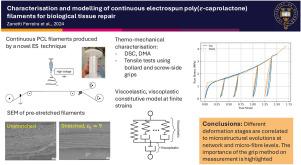Characterisation and modelling of continuous electrospun poly(ɛ- caprolactone) filaments for biological tissue repair
IF 3.5
2区 医学
Q2 ENGINEERING, BIOMEDICAL
Journal of the Mechanical Behavior of Biomedical Materials
Pub Date : 2024-11-17
DOI:10.1016/j.jmbbm.2024.106810
引用次数: 0
Abstract
This study investigates the mechanical behaviour of poly(-caprolactone) (PCL) continuous filaments produced by a novel electrospinning (ES) method. These filaments can be processed into woven or braided structures, showing great promises as scaffolds for ligament and tendon repair. Mechanical characterisation of the filaments using DMA and uniaxial tensile tests shows that the filament response is viscoelastic–viscoplastic. Filaments tested using bollard grips present an initially linear elastic response, followed by plastic yielding with two-stage hardening. The filaments are highly stretchable, reaching more than 1000% strain. The different deformation stages are correlated to the evolution of the micro-fibre network observed using SEM, involving the untangling, alignment and stretching of the fibres. A large deformation viscoelastic–viscoplastic model is proposed, which successfully captures the mechanical response of the filaments under non-monotonic loading conditions. Our study also highlights the sensitivity of the measured mechanical response to the type of mechanical grips, namely bollard or screw-side grips.

用于生物组织修复的连续电纺聚(ɛ-己内酯)丝的特性和建模。
本研究探讨了通过新型电纺丝(ES)方法生产的聚(ɛ-己内酯)(PCL)连续细丝的机械性能。这些长丝可加工成编织或编结结构,有望用作韧带和肌腱修复的支架。使用 DMA 和单轴拉伸测试对长丝进行的机械特性分析表明,长丝的反应是粘弹性-粘塑性的。使用系缆夹具测试的长丝最初呈现线性弹性响应,随后出现塑性屈服和两阶段硬化。长丝具有很强的拉伸性,应变超过 1000%。不同的变形阶段与使用扫描电子显微镜观察到的微纤维网络的演变相关,包括纤维的解开、排列和拉伸。我们提出了一个大变形粘弹性-粘塑性模型,它成功地捕捉到了非单调加载条件下纤维丝的机械响应。我们的研究还强调了所测得的机械响应对机械夹具类型(即系索或螺钉侧夹具)的敏感性。
本文章由计算机程序翻译,如有差异,请以英文原文为准。
求助全文
约1分钟内获得全文
求助全文
来源期刊

Journal of the Mechanical Behavior of Biomedical Materials
工程技术-材料科学:生物材料
CiteScore
7.20
自引率
7.70%
发文量
505
审稿时长
46 days
期刊介绍:
The Journal of the Mechanical Behavior of Biomedical Materials is concerned with the mechanical deformation, damage and failure under applied forces, of biological material (at the tissue, cellular and molecular levels) and of biomaterials, i.e. those materials which are designed to mimic or replace biological materials.
The primary focus of the journal is the synthesis of materials science, biology, and medical and dental science. Reports of fundamental scientific investigations are welcome, as are articles concerned with the practical application of materials in medical devices. Both experimental and theoretical work is of interest; theoretical papers will normally include comparison of predictions with experimental data, though we recognize that this may not always be appropriate. The journal also publishes technical notes concerned with emerging experimental or theoretical techniques, letters to the editor and, by invitation, review articles and papers describing existing techniques for the benefit of an interdisciplinary readership.
 求助内容:
求助内容: 应助结果提醒方式:
应助结果提醒方式:


